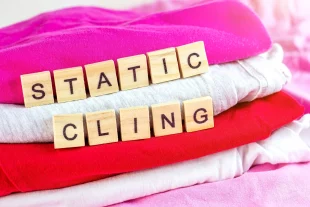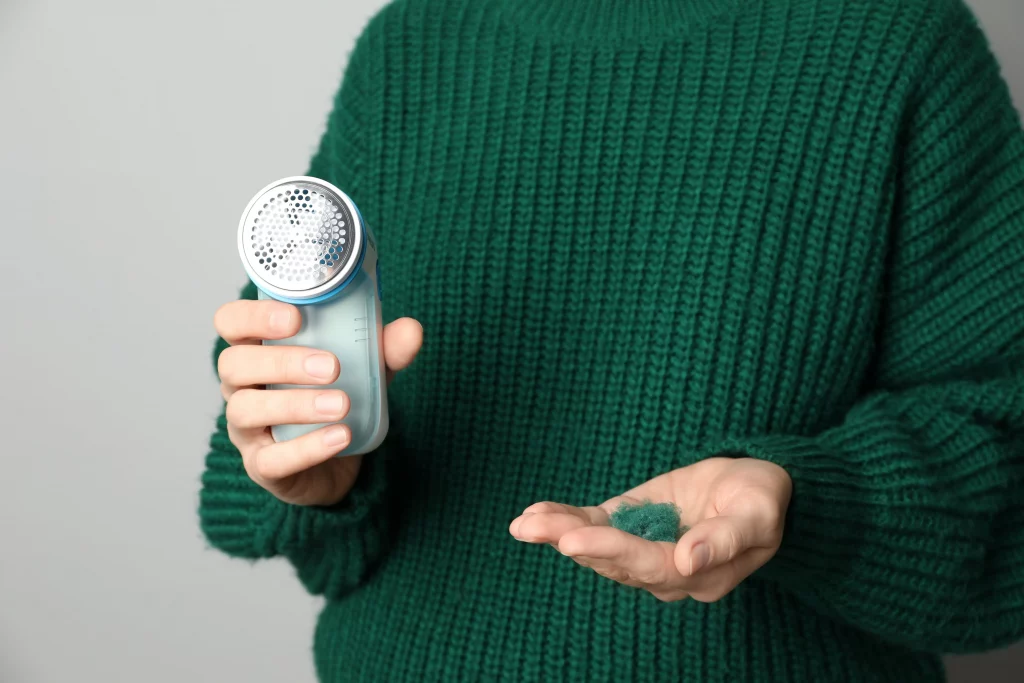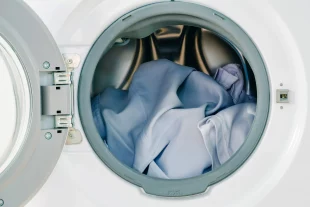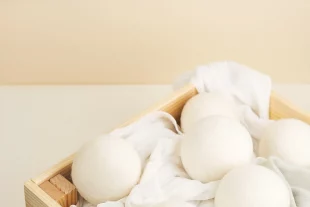 Get How-To's
Get How-To's
How to Get Rid of Static Cling
👗New Service Alert – Quinceanera Dress Preservation!
Read tips, tricks, and how-to’s on our Fabric of Life blog.
Garment Guides

Fabric pilling is a common and stubborn issue affecting many of our favorite clothing items. It describes the tiny, tangled balls of fiber that cling to the surface of fabrics, often appearing on upholstery and delicate items like sweaters. Pilling occurs when fabric fibers break down, loosen, and tangle together. While these little balls, or “pills,” are a normal result of friction from everyday wear, understanding the causes and prevention methods can help reduce pilling.
Friction is a primary culprit in causing fabric pilling. When fabrics rub against one another or experience friction from washing machines, sitting, or general wear, loose fibers break free and entangle, forming pills. Certain spots on your clothes, like the underarms and cuffs, are like friction hotspots. These areas get a lot of rubbing, and that’s where you’re likely to see those annoying pills. By paying attention to these high-friction zones, you can take some steps to protect your clothes and keep them from wearing out too soon.
Another classic example can be seen with sweaters and trousers, which are often made from delicate fibers such as silk, wool or cotton. When put into a washing machine, these fibers are put under pressure and endure friction as they rub against other clothing items. The dryer adds to this problem, as high heat and tumbling can cause even more loose fibers to form on the sweater’s surface.
There are certain fibers naturally prone to more fabric pilling than others. One example is synthetic fibers such as polyester or acrylic which tend to pill at an increased rate compared to natural fabric fibers. The main reason for this is that synthetic fibers are stronger and stretchier meaning that rather than falling off, the pills hang on to the clothing and accumulate overtime.
On the other hand, natural fabric does not have the same strength as synthetic fabric; the fabric pill might fall off as the fibers break under the stress. This means that while they are still forming, these little pills don’t collect and consume your clothes.
The length and type of fiber used in a fabric significantly influences its susceptibility to pilling. Longer fibers have fewer ends per unit area, which tends to lead to less fuzz on the surface. More friction between longer fibers makes it more difficult for them to slide out, preventing fuzz formation or tangling into balls. Fabrics made from shorter fibers, like those found in wool or cotton blends, are more prone to pilling. The shorter strands in these fabrics can easily break away from the weave, leading to the development of pills.
Additionally, synthetic pills tend to remain attached to the fabric longer than those made from natural fibers, which often shed more readily. This difference highlights the importance of fiber length and type in determining how well a fabric will hold up against wear and pilling, making longer, higher-quality fibers a preferable choice when considering the lifespan of your garments.
Several other factors contribute to the degree of fabric pilling. High-traffic areas, where fabric frequently rubs against itself or other materials, are particularly susceptible to increased pilling. Additionally, garments with loose strands, threads, or excess fibers on the surface are more likely to pill. Loosely woven fibers also carry a higher risk of tangling and breaking, which can lead to further pilling. By understanding these factors, you can better protect your fabrics from the effects of wear and maintain their appearance.
Your first line of defense against fabric pilling is to choose the right fabric type for your lifestyle. If you are picking out a fabric for a sofa, rug, or everyday clothing, you will want something with stronger fibers or natural fibers. Investing in these durable fabrics may come with a high price tag, but will save you a great deal of frustration later down the road. That said, if you are choosing a fabric type for something like a wall tapestry or a lampshade, you can get away with weaker fibers as these items will endure less friction.
One of the first steps to reducing fabric piling in a washing machine is to always turn your clothing inside out before washing. The simple step is highly effective at reducing the friction on the outside of the clothing, reducing visible pilling. This piece of advice reins true whether you are washing jeans, blouses, sweaters, or tablecloths.
Another important factor is the choice of detergent. Harsh detergents containing strong chemicals can weaken fabric fibers, making them more prone to pilling. Instead, look for labels that indicate the detergent is “gentle” or “suitable for delicate fabrics.” The formulas for these detergents were designed with delicacy in mind, making them gentle enough to limit fabric pilling. You can also opt to use a fabric softener alongside your regular detergent for additional protection.
Proper care isn’t only important when washing your favorite garments. It is best to avoid high heat drying cycles, as these can weaken fibers and contribute to pilling. When it comes to upholstery, try to position furniture in lower-traffic areas to minimize excess wear. Lastly, when cleaning fabric surfaces, use gentle, circular motions to avoid pulling on the fibers, which can lead to the formation of pills. These few additional tips can make a significant difference in the amount of fabric pilling that occurs.
Choosing a detergent is key when it comes to caring for your clothes and preventing pilling issues down the road. Detergent options, with chemicals, can harm fabric fibers. Increase pilling risks. Find detergents labeled as “gentle” or “designed for fabrics” as they are formulated to treat delicate fabrics with care and reduce pilling concerns.
The good news is that even if fabric pilling occurs, many tools can be used to remove these pesky small balls. Here are just a few of the most common pill-removal tools:
If you need a bit more help, a professional laundry and dry-cleaning service can be a viable option. With specialized services, these professionals can restore a preserve fabric quality. CD One Price Cleaners is an option, for people living in the regions of Chicago, Minneapolis, and St. Louis. By utilizing the services of CD One Price Cleaners you can prolong the lifespan of your clothing with expert care and methods.
We think you may like
 Get How-To's
Get How-To's
How to Get Rid of Static Cling
 Get How-To's
Get How-To's
How to Wash Silk
 Get Garment Guides
Get Garment Guides
How to Use Wool Dryer Balls